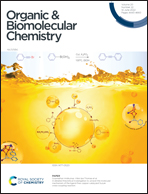Asymmetric C(sp3)–H borylation: an update
Abstract
Chiral organoboronates have emerged as a key intermediate in the development of pharmaceuticals and materials science. Therefore, several attempts have been made to design various synthetic methods to easily furnish these compounds during the past few decades. Inter alia, asymmetric catalysis has been increasing rapidly as a viable, practical and beneficial strategy for their preparation. In this respect, recent years have witnessed significant progress in aliphatic C–H borylation as the generated carbon–boron bonds are largely utilized to produce other carbon–carbon, carbon–nitrogen and carbon–oxygen bonds. This review presents a detailed overview and analysis of transition metal-catalyzed asymmetric C(sp3)–H borylation strategies. Overall, it assembles all the recent developments in this particular synthetic avenue up to March 2022.



 Please wait while we load your content...
Please wait while we load your content...